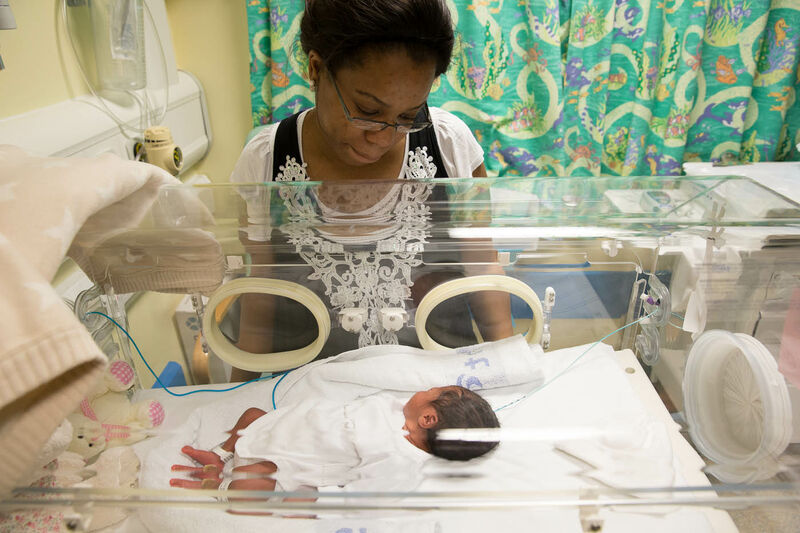The ductus arteriosus is an extra blood vessel which all babies have in the womb. It connects the two main blood vessels leaving the heart. These are called the aorta and pulmonary artery. Before a baby is born, the ductus arteriosus diverts blood from the lungs to the rest of the body.
After your baby is born, their lungs will fill with air, and blood will flow to their lungs. The ductus arteriosus is then not needed, and usually closes over the first few days of life.
In some babies, particularly babies born premature, the ductus arteriosus may not close properly. If it stays open (patent), it is called a patent ductus arteriosus (PDA). You may hear this being called persistent ductal arteriosus.
Although PDAs are more common in babies born premature, they can also occur in babies born at term.
What are the signs of a PDA?
Your baby is likely to be diagnosed with a PDA on the neonatal unit.
Doctors may suspect a PDA in your baby if they have had difficulty coming off a mechanical ventilator or continuous positive airway pressure (CPAP) machine. Your baby may have needed one of these treatments if they had experienced respiratory (breathing) distress shortly after birth.
If your baby’s doctor suspects that your baby has a PDA, they detect it by using a device that is used to listen to the heart called a stethoscope.
The most common sign of a PDA is a heart murmur. This is an extra or unusual sound that is made by your baby’s heart.
Other signs that your baby might have a PDA include:
- having a fast heart rate
- low blood pressure
- low blood oxygen levels
- pauses in breathing (apnoea)
- poor feeding or poor weight gain
- chest infections.
The signs that your baby will have will depend on the size of the PDA. A baby who has a small PDA may have no signs at all.
What tests might my baby have?
Your baby will have an echocardiogram (ECHO). This is an ultrasound scan that uses waves to look at the heart and nearby blood vessels. It is used to confirm a diagnosis of a PDA and to look at its size.
The treatment that is used to treat the PDA will depend on its size. Possible treatments include the following:
Monitoring
Doctors may monitor the PDA to see if it closes on its own before starting treatment.
Your baby may be discharged from the neonatal unit during this time, but will have follow-up appointments to monitor the progress of the PDA.
You know your baby best. You should speak to someone if you are worried about your baby when you are at home, such as your GP or health visitor.
If, when your baby is at home, they show signs of shortness of breath, long pauses in their breathing or go pale or blue, call 999 straight away.
Medication
If the PDA is large, doctors may give your baby a water medicine called a diuretic. Diuretics help to reduce the amount of fluid on the lungs. This should help your baby to breathe more comfortably.
If, after some time, the PDA does not close and your baby has difficulty coming off breathing support, medication such as ibuprofen is used to try to close it. This is given intravenously (into a vein). Other medications may be used if your baby is unable to take ibuprofen.
Your doctor will explain the benefits and risks of any medications to you. If you have any questions or there is anything you do not understand, ask your doctor to explain it again or in a different way. They are there to help and answer any questions you have.
Surgery
If medication does not close the PDA, doctors may suggest surgery. There are two types of surgery that are used to close a PDA:
Keyhole surgery
Most PDAs are small, so can be successfully closed using keyhole surgery. This surgery involves passing a long thin tube (catheter) through a vein or artery in the heart. The ductus arteriosus is then sealed using a small stainless-steel coil or plug.
Surgical ligation
This may be needed if your baby has a large PDA. During this surgery, a surgeon will make a small cut on the left side of your baby’s chest. They will then put a metal clip around the ductus arteriosus to close it.
For both types of surgery, your baby will be put under general anaesthetic (put to sleep).
The idea of your baby having surgery may seem like a scary thought. But surgery to treat a PDA is usually successful and many babies recover quickly. The surgeons will explain what they plan to do before surgery and talk about what will happen and any risks with you.
The British Heart Foundation has a factsheet about PDA which includes more information about these types of surgery.
Most babies who have a PDA will need no further treatment once it is closed successfully and will have no ongoing health problems.
If the ductus arteriosus is large and is left untreated, this can cause pulmonary hypertension (high blood pressure in the lungs). It can also increase the risk of developing a condition called necrotising enterocolitis (NEC).
Babies who need surgery to close the ductus arteriosus may already have existing conditions that are linked to their prematurity. This might mean that there is a higher risk of them developing problems with their lungs such as chronic lung disease (CLD).
If you have any questions or concerns about any effects of having a PDA, speak to your baby’s healthcare team. They are there to help and answer any questions you have.
In a survey we conducted of 190 parents, 86% of parents had never heard of or knew little about PDA before their baby had it.
If your baby has a condition that you don’t know much about or is new to you, you may feel overwhelmed and worried. How you feel and process what has happened to you might be different to others who face these challenges.
If you are unsure about any part of your baby’s diagnosis, treatment or care, the staff on the unit will help you in any way they can. It is okay to ask again if you need information repeated or made clearer. The team will understand and want to support you.
We have included some links to charities and organisations who can provide more support.
Social media websites such as Facebook may also be able to provide information about local support groups and charities where you can talk to other parents who have a baby with a condition such as a PDA.
Your unit may also be able to provide you with this information. If you need someone to talk to, you can also contact us on [email protected] or arrange a video call with one of our volunteers.
- British Heart Foundation (BHF) funds research into heart and circulatory diseases and provides information and support. They have a helpline and email support service, and a factsheet on their website for parents with a baby with a PDA.
- Children’s Heart Foundation (CHF) provides information and support for children with heart conditions and their families and has a factsheet on PDA.
- Tiny Tickers works to improve the early detection and care of babies with heart conditions and has a fact sheet on PDA.



